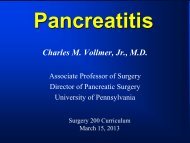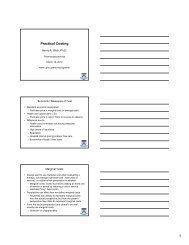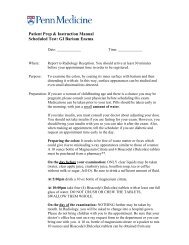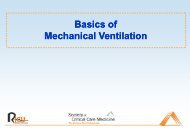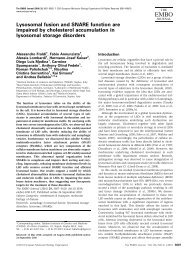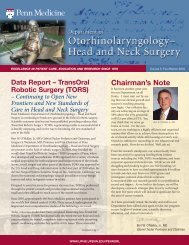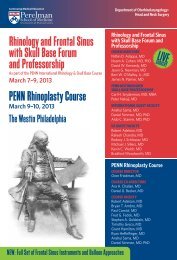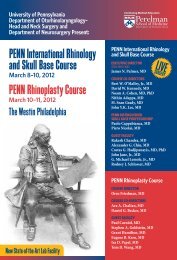Essentials of water treatment in hemodialysis - Penn Medicine
Essentials of water treatment in hemodialysis - Penn Medicine
Essentials of water treatment in hemodialysis - Penn Medicine
You also want an ePaper? Increase the reach of your titles
YUMPU automatically turns print PDFs into web optimized ePapers that Google loves.
Ahmad<br />
<strong>of</strong> several devices is needed to produce <strong>water</strong> that can be<br />
used for dialysis.<br />
TYPICAL WATER TREATMENT SYSTEM<br />
The design <strong>of</strong> a <strong>water</strong> <strong>treatment</strong> system is dependent on<br />
the quality <strong>of</strong> feed <strong>water</strong> and local requirements <strong>of</strong> the<br />
purity standards. One typical scheme commonly used is<br />
shown <strong>in</strong> Figure 2; this system will be first discussed and<br />
then common variations would be further elaborated.<br />
BACKFLOW-PREVENTING DEVICE (BFD)<br />
The feed <strong>in</strong> <strong>water</strong> first comes <strong>in</strong> the unit and goes through<br />
a backflow-prevent<strong>in</strong>g device; this is essentially a valve<br />
that prevents the dialysis unit <strong>water</strong> flow<strong>in</strong>g back <strong>in</strong>to the<br />
city/build<strong>in</strong>g supply <strong>water</strong>. Often this device is supported<br />
by an additional booster pump that helps ma<strong>in</strong>ta<strong>in</strong> the<br />
necessary m<strong>in</strong>imum pressure despite fluctuat<strong>in</strong>g pressure<br />
and flow from the feed l<strong>in</strong>e.<br />
TEMPERATURE-BLENDING VALVE (TBV)<br />
The reverse osmosis (RO) unit works most efficiently if<br />
feed <strong>water</strong> temperature is 77 F. A heater and blend<strong>in</strong>g<br />
valve assures a constant desired temperature by blend<strong>in</strong>g<br />
heated <strong>water</strong> with cold <strong>water</strong>. This unit is sometimes<br />
placed right at the beg<strong>in</strong>n<strong>in</strong>g <strong>of</strong> the <strong>water</strong> system and<br />
sometimes more distally.<br />
FILTERS<br />
Table 1 Comparison <strong>of</strong> advantages and disadvantages <strong>of</strong> various <strong>water</strong> purification devices<br />
A series <strong>of</strong> <strong>in</strong>creas<strong>in</strong>gly tighter filters (with smaller pores)<br />
are placed <strong>in</strong> the <strong>water</strong> l<strong>in</strong>e. In Figure 2, these are shown<br />
Benefits Limitations<br />
1. S<strong>of</strong>teners<br />
Effectively removes Ca, Mg (hardness) Ineffective at remov<strong>in</strong>g other contam<strong>in</strong>ants<br />
Inexpensive Difficult to sanitize<br />
Easy to regenerate Needs frequent regeneration<br />
Res<strong>in</strong> exhaustion leads to hard <strong>water</strong><br />
Promotes bacterial growth<br />
2. Activated carbon<br />
Effective at remov<strong>in</strong>g organic contam<strong>in</strong>ants,<br />
Exhaustable adsorptive capacity, risk <strong>of</strong> spillover<br />
chlor<strong>in</strong>e, and chloram<strong>in</strong>e<br />
I<br />
O<br />
City Water<br />
Feed Water<br />
E M E M<br />
O P I O P I<br />
Product Water<br />
Ultrafiltration<br />
(1000 Da)<br />
M<br />
P<br />
E<br />
O<br />
M O O<br />
E<br />
I<br />
E M E M<br />
O P I O P I<br />
Deionizer Reverse<br />
Osmosis<br />
Distillation<br />
Figure 1 Commonly used <strong>water</strong> purification devices. P ¼<br />
particulate matter; I ¼ <strong>in</strong>organic ions and salts; O ¼ organic<br />
matter; M ¼ microorganisms; E ¼ endotox<strong>in</strong>s.<br />
Inexpensive Promotes bacterial growth<br />
Difficult to sanitize<br />
Releases ‘‘f<strong>in</strong>es’’ (abrasive particles)<br />
3. DI<br />
Effective at remov<strong>in</strong>g ions Ineffective at remov<strong>in</strong>g organics and microorganism<br />
Low ma<strong>in</strong>tenance cost Facilitates bacterial growth<br />
Easy to regenerate Release <strong>of</strong> particles<br />
Risk <strong>of</strong> spillover with exhaustion <strong>of</strong> res<strong>in</strong>s<br />
4. RO<br />
Removes almost all dissolved ions Needs pre<strong>treatment</strong><br />
Removes almost all organisms and fragments Uses large quantities <strong>of</strong> <strong>water</strong><br />
Life <strong>of</strong> membrane depends on quality <strong>of</strong> <strong>water</strong><br />
128 Hemodialysis International 2005; 9: 127–134



